Summary of December itinerary in Japan (Aomori / Akita trip)
In Tohoku (Aomori and Akita prefectures), where I traveled from Saturday, December 11th to Tuesday, December 14th, I was able to eat a lot of seasonal fish and shellfish and local dishes, which was a very satisfying trip. This is the December Japan itinerary that I highly recommend to everyone. In addition, I was able to visit many wonderful tourist destinations such as national important cultural properties. Here is a summary of this trip and some notes.
Table of contents
1.”100 selections of local dishes” and “Local dishes loved by the nation” by this itinerary in Japan
2. Seasonal “PRIDE FISH” eaten in this Japanese itinerary
3. Travel precautions (local trains) for itinerary in Japan
5. December 11 (Saturday) Aomori Prefecture Day 1
6. December 12 (Sunday) Aomori Prefecture Day 2
7. December 13 (Monday) Aomori Prefecture Day 3
8. December 14 (Tuesday) Akita Prefecture Day 1
This itinerary was also created with the purpose of “eating out seasonal seafood and local dishes.” Food is the highest priority, and tourist destinations are the second priority. However, we aimed to visit as many tourist spots as possible, such as national important cultural properties. On this trip, it snowed for the latter two days, and the limited express train I was planning to board was suspended. However, my purpose was to eat delicious fish and shellfish that can only be eaten in Tohoku in winter, so the snow didn’t bother me at all. However, it is advisable to travel slowly in winter with plenty of time.
1.”100 selections of local dishes” and “Local dishes loved by the nation” by this itinerary in Japan
Aomori: None
Akita Prefecture: Kiritanpo Nabe (hotpot), Inaniwa Udon, Yokote Yakisoba
The Kiritanpo Nabe had a simple taste and was delicious.

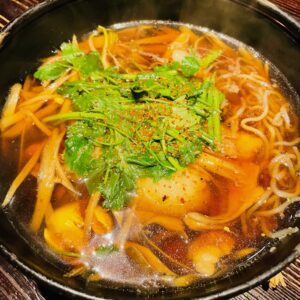


“Inaniwa Udon” is said to be “Japan’s Three Great Udon” along with Kagawa’s “Sanuki Udon” and Gunma’s “Mizusawa Udon”. “Inaniwa Udon” is mostly dried noodles, but “Kanbun Gonendo” also offers raw noodles.
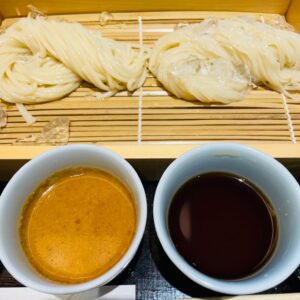


I was reluctant to eat Yokote’s local cuisine in Akita City, but it was delicious enough when I ordered it just in case. Someday I would like to eat authentic “Yokote Yakisoba” in Yokote City.
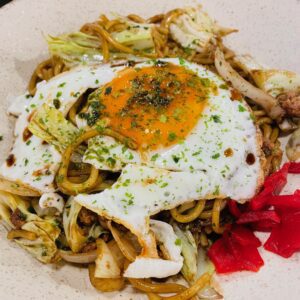


“100 selections of local dishes” and “Local dishes loved by the nation” are selected by the Ministry of Agriculture, Forestry and Fisheries.
In Aomori prefecture, I couldn’t eat “100 selections of local dishes” and “Local dishes loved by the nation”. In Aomori prefecture, “Local dishes loved by the nation” is not selected. In addition, “100 selections of local dishes” are selected from “ichigo-ni” and “senbei-jiru”, which are the local dishes of Hachinohe that I didn’t go to this time.
Even in Aomori Prefecture, there are many differences in food culture between Hachinohe, the former Nambu clan, and the Tsugaru area (Aomori City, Hirosaki City, etc.) of the former Hirosaki Clan (Tsugaru Clan). I think the selection of local dishes centered around Hachinohe has greatly discouraged the people of the Tsugaru area.
I had “Jappa soup” in Aomori city, which is a local dish of Aomori city. “Jappa” is a Tsugaru dialect meaning “rough”, and is a dish of seafood such as chopped cod and vegetables simmered together.
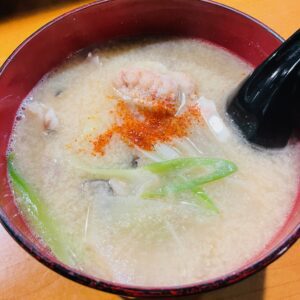


I also ate “Miso Curry Milk Ramen” (880 yen), which is a local gourmet in Aomori City, at the popular ramen shop “Ajino Sapporo Onishi”. Because it contains milk, it has a very mild taste and is easy to eat, so I ate it all at once.



In Kuroishi City, I had local gourmet “Igamenchi” and “Tsuyu Yakisoba“. “Igamenchi” is a local dish in the inland area of Tsugaru centered on Hirosaki City. Squid leg is beaten with a kitchen knife, mixed with seasonal vegetables, and baked or fried in oil. “Iga” is a Tsugaru dialect and means squid.



“Tsuyu Yakisoba” is said to have started with soba soup sprinkled on Yakisoba so that it can be eaten warmly even on cold days. The mainstream noodles are thick and flat noodles, fried noodles fried in Worcestershire sauce, sprinkled with soup, and topped with fried balls and green onions. I have eaten various local gourmet foods, but it was top class.



In Hirosaki City, I had miso ramen at “Nakamiso” in the basement of the Nakasan Hirosaki store, which is a local gourmet.



The “Nishin (herring) Kirikomi“, which is a local dish of Hokkaido and Tohoku that I ate in Aomori City, was also impressively delicious. “Nishin (herring) Kirikomi” is made by chopping herring with a kitchen knife and fermenting it. In addition to herring, salmon and flatfish may be used.



In Akita City, I also ate “Iburi-gakko“, a local dish of Akita. I think “Iburi-gakko” and cream cheese go well together. In Akita prefecture, pickles are called “gakko”.
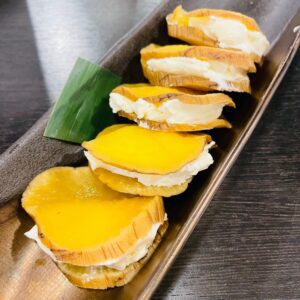


In this way, on this trip, I was able to eat various local dishes and local gourmet foods in addition to the “100 selections of local dishes” and “Local dishes loved by the nation” selected by the Ministry of Agriculture, Forestry and Fisheries.
2. Seasonal “PRIDE FISH” eaten in this Japanese itinerary
Aomori Prefecture: Aomori flounder, Aomori Sakhalin surf clam
“Aomori Flounder” (season: September-December) was beautiful, sweet and delicious.



“Misawa Hokki Don” is a local gourmet of Misawa City, which is “using Misawa surf clams (fished during the period from December 1st to March 31st when the ban on fishing is lifted)”.
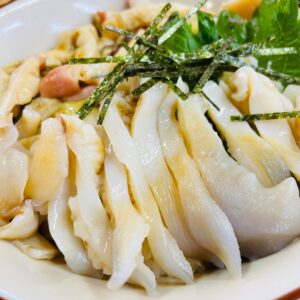


Akita Prefecture: Akita Hatahata (Japanese sandfish)
There is a quota that Hatahata fishing can only be operated for 12 to 17 days offshore and 22 days offshore. Therefore, it is a very valuable fish. Especially in recent years, it has become difficult to eat raw sandfish even in Akita. In particular, the catch of females with eggs is decreasing. The bubble wrap texture of the large egg (Brico) was unbearably delicious.



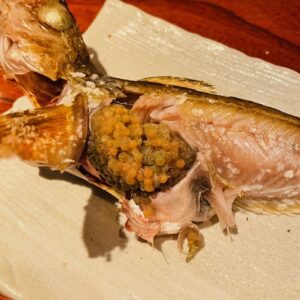


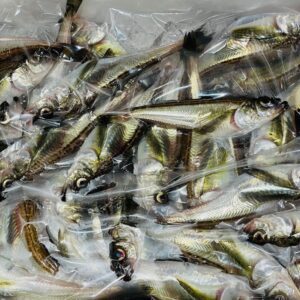


“PRIDE FISH” is selected by Japan Fisheries Co-operative.
3. Travel precautions (local trains) for itinerary in Japan
I write the same thing every time, but it’s important, so I repeat it. This time as well, the rule of travel is an environment-friendly trip that uses only public transportation including rental bicycles.
Again, this is a reconfirmation, but traveling by public transport has far less CO2 emissions than traveling by car. For example, according to data from the Ministry of Land, Infrastructure, Transport and Tourism, CO2 emissions when one person travels 1 km are 130 g for automobiles, 98 g for aircraft (75% for automobiles), 57 g for buses (44% for automobiles), and 17 g for railways (13% for automobiles).
It was difficult to understand how to get on and off the one-man operated train this time as well. “Aomori Railway” (I ride from Misawa Station to Aomori Station), “Konan Railway” (I went back and forth from Hirosaki station to Kuroishi station), JR Ou Line (I ride from Hirosaki Station to Akita Station) were a one-man operated train.
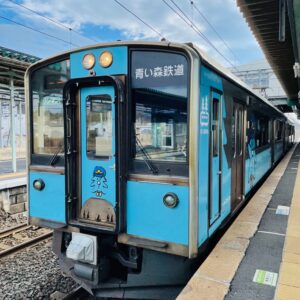



When getting on and off a one-man operated train, you need to press a button to open the door.


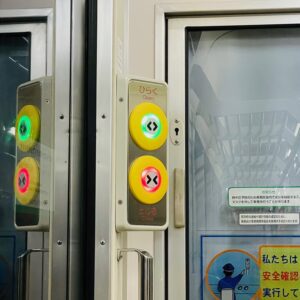

When you get on the train, take a numbered ticket, and when you get off, put the numbered ticket and money in the fare box and get off.
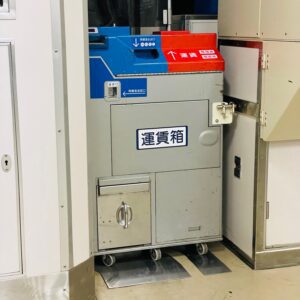

There was a poster in the car about how to get on and off, but it was only in Japanese. Railroad operators and tourist associations should be responsible for providing guidance in foreign languages.


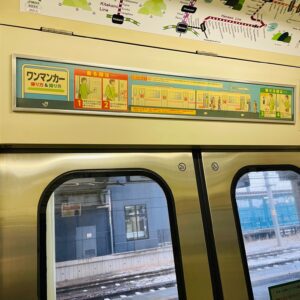

In the case of a one-man operated train, it is safe to always get on the first car. Be sure to remember the train boarding / alighting rules when traveling in rural areas of Japan. However, it depends on the railway operator whether you ride from the front door or the rear door of the first car.
Please see the detailed notes written on each travel day.
4. Travel in a light style
Again, I sent my clothes and power cord to my accommodation in advance for this trip, and enjoyed the “luggage free trip” every day. After all, it is very easy to travel in a light style like taking a walk. Being able to act immediately after arriving by train or plane is important for effective use of time.
Also, like this time, when it snows, transporting the suitcase becomes many times more difficult than on a road without snow. I want you to travel as “luggage free trip” in winter. Again, on the last day of the trip, I sent the clothes I wore during the trip to the laundry agent and did not have to do the laundry. I want everyone to experience the comfort of “luggage free trip”.
5. December 11 (Saturday) Aomori Prefecture Day 1
I could see a very beautiful view from the plane of JAL153 flight from Haneda Airport to Misawa Airport. In particular, I was surprised that the morning sun was reflected in the sea and the color was burning.
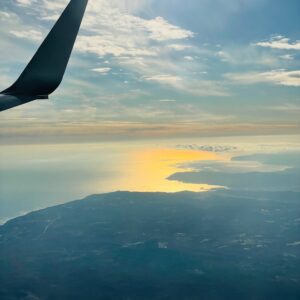





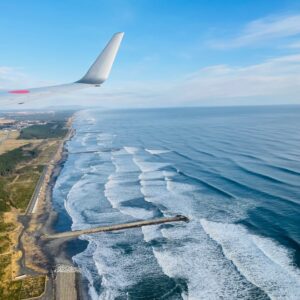

I landed at Misawa Airport and took a taxi to the Misawa Aviation Science Museum in Aomori Prefecture.
Misawa has been deeply involved since the early days of aviation history, including becoming the starting point for the Miss Veedol, which succeeded in the world’s first successful non-landing crossing of the Pacific Ocean in 1931.
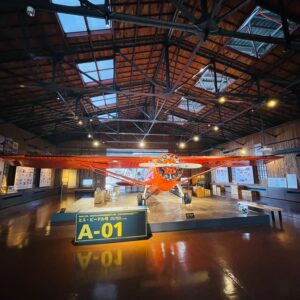

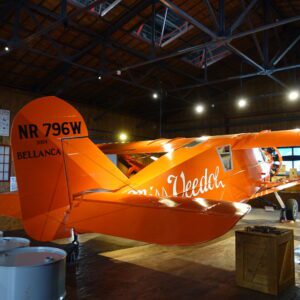

In addition to the Miss Veedol, replicas of the Narahara-shiki Unit 2, Shirato-shiki Asahi, and Gasuden Koken are on display.
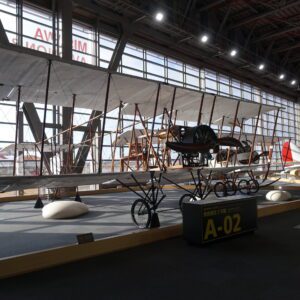

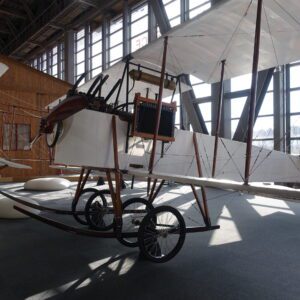

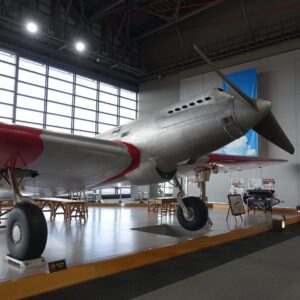

Also on display are the HondaJet and flying cars (mockups).
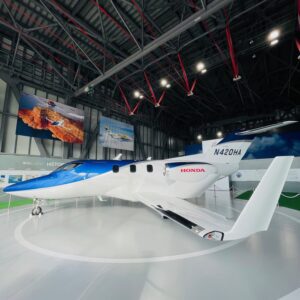

In addition to the airplane exhibition, there were also experience facilities such as flight simulators, and it was crowded with many families.


“Nebuta Museum Wa Rasse” is located in a very convenient location, just a minute’s walk from Aomori Station. On the 1st floor, a large Nebuta that was used for the festival is on permanent display. I was impressed by the splendor as an artistic work and the power of the size of 9m in width, 7m in depth and 5m in height.





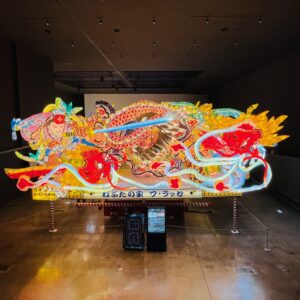

On the 2nd floor, the history of the Nebuta Festival and the works of masters (master craftsmen) who made Nebuta are exhibited. I thought that the master’s work was wonderful because it was a work with a calm color that was not flashy.
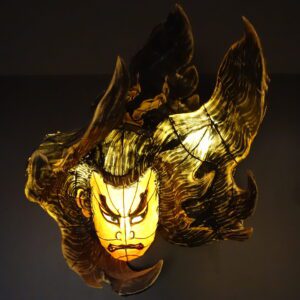

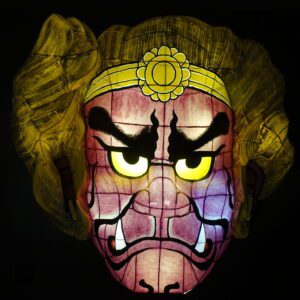



The Aomori Nebuta Festival is designated as a national important intangible folk cultural property.
The Seikan Ferry is a railway ferry that operated Aomori Port and Hakodate Port for 80 years from 1908 to 1988. A railroad ferry is a ship in which a railroad vehicle, which is extremely rare in the world, crosses the sea through a ship.
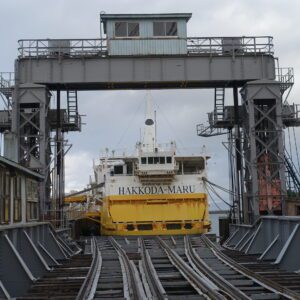

There were few tourists on board the Hakkoda Maru. The lighting on the old railroad car was dim, and the car seemed to be standing while sleeping, which seemed to tell the history of the Seikan Ferry, and I personally liked it very much.


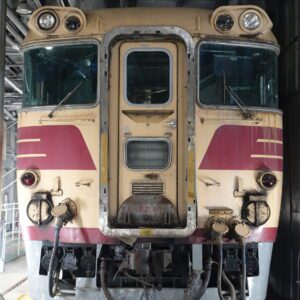

The huge engine that I saw up close was also wonderful because it was powerful as a power source for the huge structure.
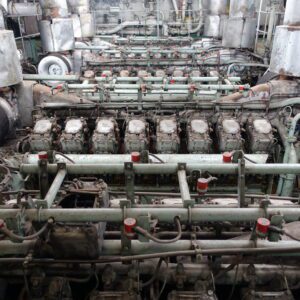

The Aomori Museum of Art is famous for “Aomori-ken” by Yoshitomo Nara. “Aomori-ken” is a huge dog with a height of 8.5m and a width of 6.7m.
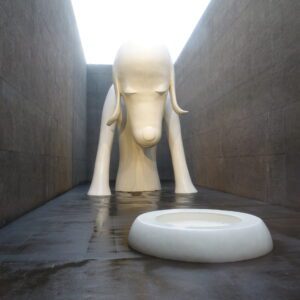

Many of Yoshitomo Nara’s works are exhibited at the Aomori Museum of Art. That’s because Yoshitomo Nara is from Hirosaki City, Aomori Prefecture. At the Aomori Museum of Art, there is also “Miss Forest” as a photographable work by Yoshitomo Nara.
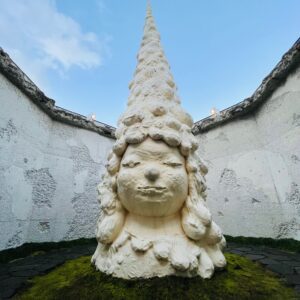

Many works by Shiko Munakata, a master of prints from Aomori City, are also exhibited at the Aomori Museum of Art. There is also a work by Shiko Munakata, which is exhibited together with the Jomon pottery. The collaboration between Jomon pottery excavated from the world heritage site “Sannai Maruyama Ruins”, which Aomori City is proud of, and Mr. Shiko Munakata, a master from Aomori City, was wonderful.


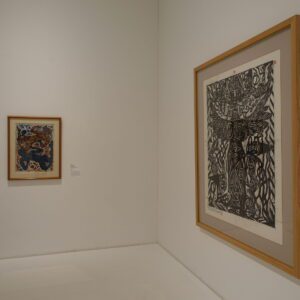

In addition, all four works of Marc Chagall’s “Aleko” are exhibited in the large hall. I was impressed by the huge painting.
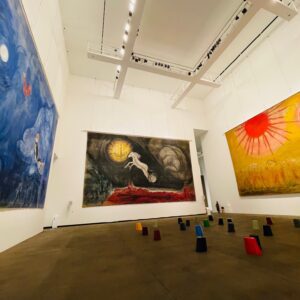

After seeing all the works, when I left the Aomori Museum of Art, the sun went down and the museum was lit up.
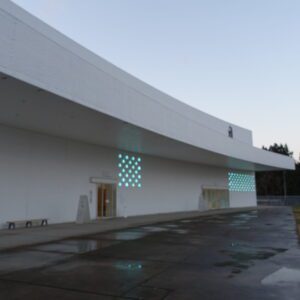

On the sandy beach of Aomori Port, there was an illumination of a Japanese paper object “Snowman” made by the citizens using the Nebuta technique. It was a very beautiful view.


Meals
First of all, I ate “Misawa Hokki Don” at “Kirakutei” in Misawa City. “Misawa Hokki Don” is a local gourmet of Misawa City, which says “uses Misawa surf clams (fished during the period from December 1st to March 31st when the ban on fishing is lifted)”.
“Misawa Hokki Don” (Yen 1,250) of “Kirakutei” is a two-color bowl of raw and boiled Sakhalin surf clams. The raw Sakhalin surf clams have a wonderful texture and sweetness, and the boiled Sakhalin surf clams are the most delicious “Misawa Hokki Don” with the perfect balance between the “Tororo (grated yam)” that was hung on the rice.



The surf clam is “PRIDE FISH” selected by Japan Fisheries Co-operative in Aomori Prefecture.
I moved from Misawa City to Aomori City and ate “Miso Curry Milk Ramen” (Yen 880), which is a local gourmet in Aomori City, at the popular ramen shop “Ajino Sapporo Onishi”.
Fumio Onishi, the owner of “Ajino Sapporo Onishi,” is Kiyoshi Sato’s most disciple. Mr. Sato ran a popular ramen shop in Sapporo Susukino Ramen Yokocho. After that, Mr. Sato moved to Aomori City to open “Ajino Sapporo” and developed “Miso Curry Milk Ramen” first in order to spread Sapporo Miso Ramen to Aomori.



“Miso curry milk ramen” was very delicious. Because it contains milk, it has a very mild taste and is easy to eat, so I ate it all at once.
I had dinner at “Izakaya Osanai”. “Izakaya Osanai” is the best izakaya for those who want to eat delicious food at a reasonable price.
Japan Fisheries Co-operative has selected “Aomori Flounder” (season: September-December) for “PRIDE FISH” in autumn in Aomori Prefecture. The natural flounder sashimi I ate on that day was also sweet and delicious.



In the middle of Aomori Prefecture, there is Mutsu Bay, which is a huge inner bay, and the scallop aquaculture industry is thriving. Due to the existence of Mutsu Bay, Aomori Prefecture has the highest production of aquaculture scallops in Japan.
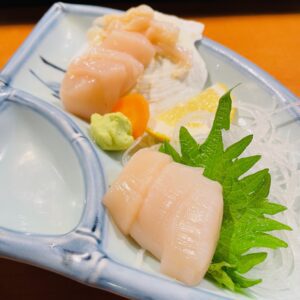

“Nishin (herring) Kirikomi” are a local dish of the Hokkaido and Tohoku regions that are fermented by chopping herring with a kitchen knife.



Jappa soup is also a local dish of the Tsugaru region such as Aomori city. It was a delicious Jappa soup that was very simple and warm.



Abalone sashimi (Yen 500) and Japanese flying squid sashimi (Yen 270) were also delicious and unimaginable due to their low price. My greatest pleasure is to discover such a wonderful izakaya while traveling.


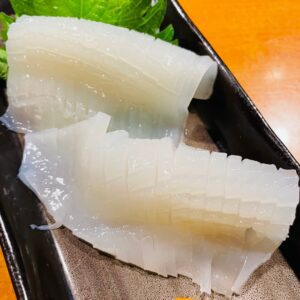

Important points
It is inconvenient to reach Misawa Aviation Science Museum by public transportation other than taxi. “MISAWA Grutto Bus” operates only on Saturdays, Sundays, and holidays, but there are only 3 buses a day from Misawa Airport (3 buses a day from November to March, 4 buses a day from April to October). Moreover, the operating hours are halfway. There are 6 flights arrivals a day at Misawa Airport (9:05, 10:55, 12:25, 14:35, 16:15, 18:40), but the “MISAWA Round Bus” The departure time for Misawa Aviation Science Museum at Misawa Airport is 10:23, 12:17, 14:07, and there is no timing for the arrival time of the plane.
Lockers at Misawa Aviation Science Museum are free of charge.
Nobody could use my credit card at Misawa station. Please have cash ready.
Great value Nebuta Museum WA-RASSE and Hakkoda-Maru common ticket (Yen 930 for adults, total Yen 1,130 for individual tickets), Nebuta Museum WA-RASSE and Aspam common ticket (adults Yen 1,070, total Yen 1,360 for individual tickets), a tour ticket for the 3 of Nebuta Museum WA-RASSE, Aspam, and Hakkoda-Maru (adults Yen 1,380, individual tickets totaling Yen 1,980).
It is important to note that “Izakaya Osanai” closes as early as 20:00 (opens at 16:00).
6. December 12 (Sunday) Aomori Prefecture Day 2
In the morning of the second day of my trip to Aomori and Akita, I moved from Aomori station to Kuroishi station and went sightseeing in Kuroishi.
Limited express Tsugaru runs on the Ou Line that connects Aomori Station and Akita Station.
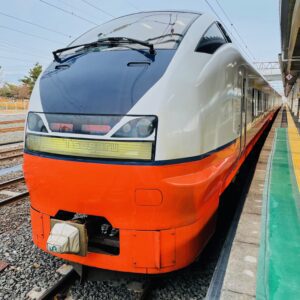

I enjoyed the view from the train window, such as seeing Mt. Iwaki on the right side of the direction of travel. Mt. Iwaki, which is an independent peak like Mt. Fuji, is also called Tsugaru Fuji. The altitude is 1,625m.
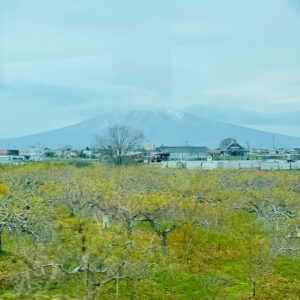

“Nakamachi Komise Street” is an arcade-shaped passage that has been around since the Edo period, and it is rare in Japan that it is left in almost perfect form. It has been selected as an Important Preservation District for Traditional Buildings in the country. Huge kokeshi dolls are lined up, and the kokeshi dolls are lit up at night.
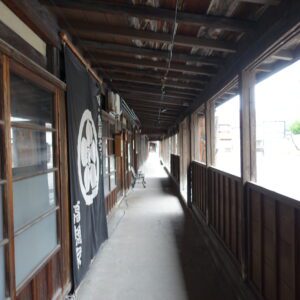

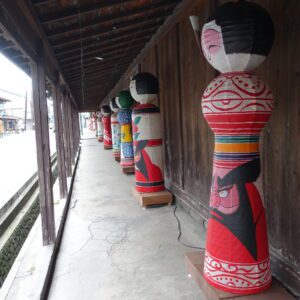

The Takahashi Family Residence, which is a typical Machiya building (commercial house building) built in 1763, is a national important cultural property.


I visited the brewery “Kikunoi” on “Nakamachi Komise Street”. “Kikunoi” was founded in 1806 and is a brewery with a very long history. You can see old books.


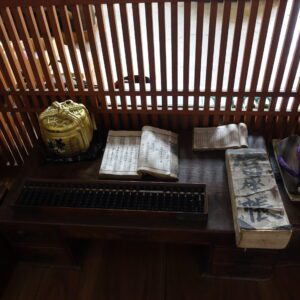

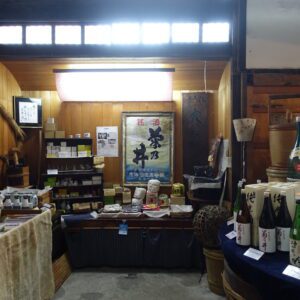

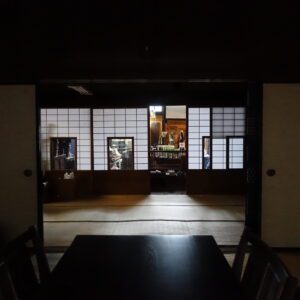

I headed from Kuroishi City to Hirosaki City and visited the Former main branch of the 59th National Bank (Aomori Bank Memorial Museum). Former Fifty-nine Bank Headquarters Main Building is a national important cultural property built in 1904.
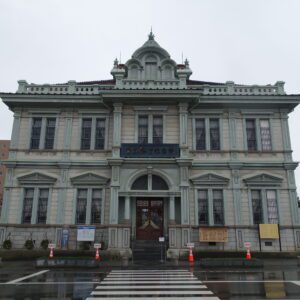

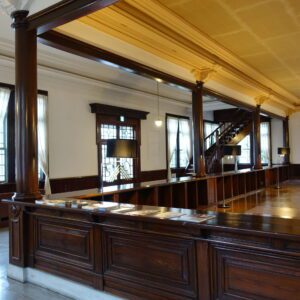

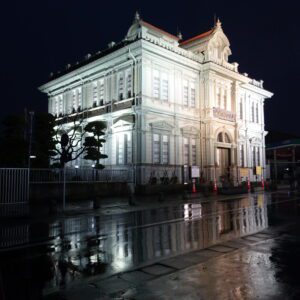

After visiting the main building of the Former main branch of the 59th National Bank, I went to Hirosaki Castle. Hirosaki Castle is one of the 12 existing castle towers and is the only existing castle tower in the Tohoku region. Currently, they are conducting a stone wall repair business, and the castle tower has been moved to a temporary castle tower base. The stone wall repair business is scheduled to continue until 2025.
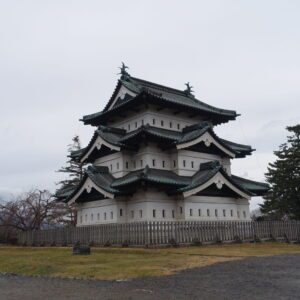

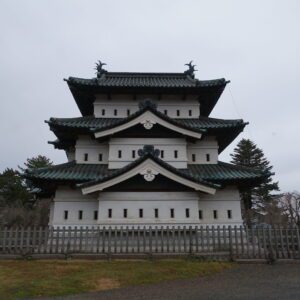

Hirosaki Castle has many national important cultural properties such as the castle tower, Tatsumi turret, Ninomaru East Gate, and Sannomaru East Gate. I was most impressed with the magnificence of the gates (Ninomaru East Gate, Sannomaru East Gate).
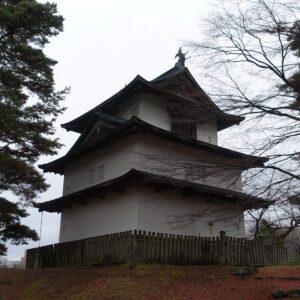

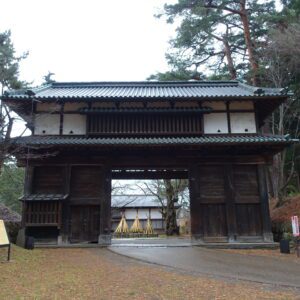



Mt. Iwaki can be clearly seen from the location of the castle tower.
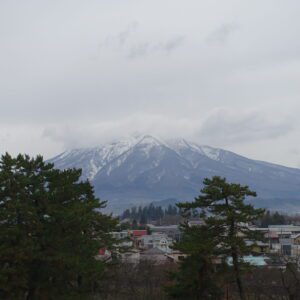

After Hirosaki Castle, I went to the Former To-o Gijuku Missionary Residence. The Former To-o Gijuku Missionary Residence was built in 1903 as a residence exclusively for foreign teachers at To-o Gijuku.


The Former Hirosaki City Library, which stands next to the Former To-o Gijuku Missionary Residence, was built in 1906. The building features octagonal three-story towers on both the left and right ends.
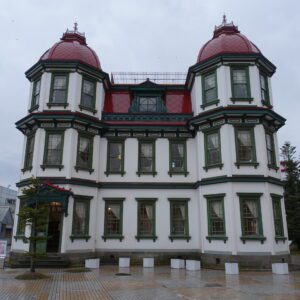

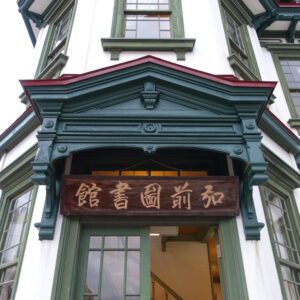

I didn’t go inside, but I took a picture of the Western-style building in the Fujita Memorial Garden. At the “Taisho Roman Tea Room” in the Western-style building, you can compare the taste of apple pies ordered from pastry shops in Hirosaki City.
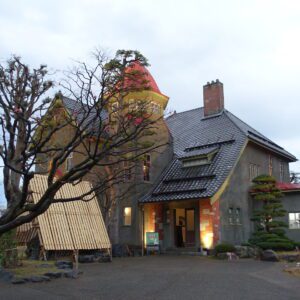

Meals
I had lunch in Kuroishi City at the creative restaurant “Kurayoshi”. First of all, the impression of “Kurayoshi” was that it was the highest level restaurant in recent years for me. The food was delicious and the service of the waitress was excellent.


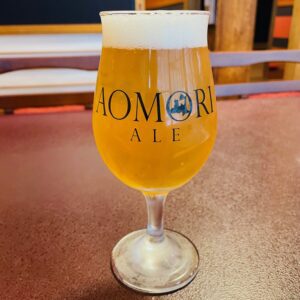

First, I drank the craft beer “Aomori Ale” from Hirosaki City, Aomori Prefecture. “Aomori Ale” can only be drunk in Aomori Prefecture. Manufactured by Be Easy Brewing, a beer company founded in 2016 by former US soldier Gareth Anson Burns.





I ordered “Igamenchi” and “Dakekimi Tempura” for the “Aomori Ale” knob. “Igamenchi” is a local dish in the inland area of Tsugaru centered on Hirosaki City. Squid leg is beaten with a kitchen knife, mixed with seasonal vegetables, and baked or fried in oil. “Iga” is a Tsugaru dialect and means squid. It had a simple taste and was delicious.
“Dakekimi” is a corn cultivated in the Dake plateau at the foot of Mt. Iwaki. It is the best corn brand with high sugar content due to the temperature difference of Mt. Iwaki. “Kimi” is a Tsugaru dialect and means corn.
The local gourmet food in Kuroishi is “Tsuyu Yakisoba”. One of the reasons I went to Kuroishi was to eat “Tsuyu Yakisoba”. “Tsuyu Yakisoba” is said to have started with soba soup sprinkled on Yakisoba so that it can be eaten warmly even on cold days. The noodles of “Tsuyu Yakisoba” are thick and flat noodles, and the noodles are fried in Worcestershire sauce, sprinkled with soup, and topped with fried balls and green onions.



“Tsuyu Yakisoba” from “Kurayoshi” is characterized by the bonito broth unique to Japanese restaurants. The yakisoba sauce mixed with the bonito broth, and it was delicious like I had never experienced before. Thanks to the bonito broth, I was able to eat it refreshingly. I have eaten various local gourmet foods, but it was top class.
I returned from Kuroishi City to Hirosaki City and went to “Cafe Buruman” during the walk. I ordered a blended coffee and a homemade apple pie.


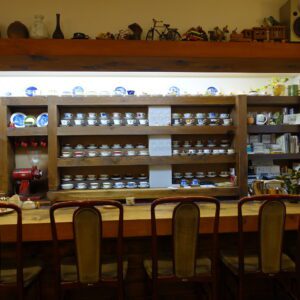

The last meal on that day was “Tsune Sushi”. The dinner at “Tsune Sushi” was wonderful. “Tsune Sushi” has many regular customers of local Hirosaki citizens, and it was almost full at 17:30.
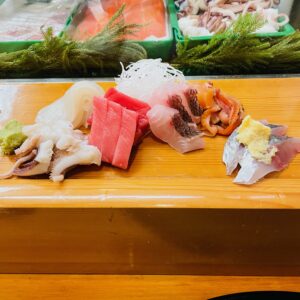

First, I asked for sashimi Omakase. I slowly ate a wide variety of sashimi such as tuna chutoro, red sea bream, ark shell string, squid, and horse mackerel.
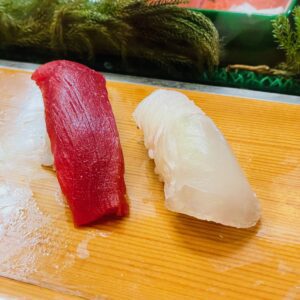



I asked for sushi Omakase as well. It wasn’t as inspiring as a high-end sushi restaurant, but it was very delicious. The ark shells, scallops, and hand-rolled sushi were the best.
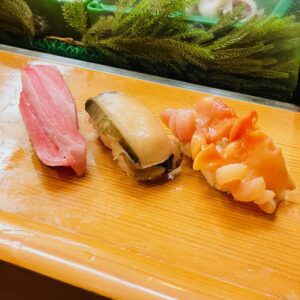

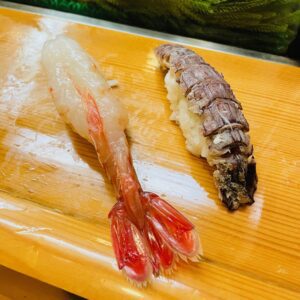

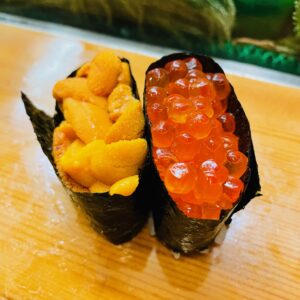

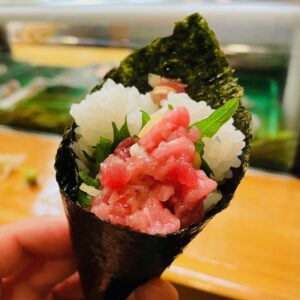

Important points
As I wrote at the beginning, the Konan Railway that runs between Hirosaki and Kuroishi is a one-man operated train, so you need to be careful when getting on and off.
Hirosaki Sightseeing is dotted with sightseeing spots around Hirosaki Park, so you can walk around.
7. December 13 (Monday) Aomori Prefecture Day 3
The third day of my trip to Aomori and Akita was heavy snow from the morning. First of all, I went to “Saishōin Five-storied Pagoda”. The “Saishōin Five-storied Pagoda” was completed in 1667. As a five-storied pagoda, it is a national important cultural property located at the northernmost place of Japan. It is said to be the most beautiful tower in the Tohoku region. It was very beautiful with snow.
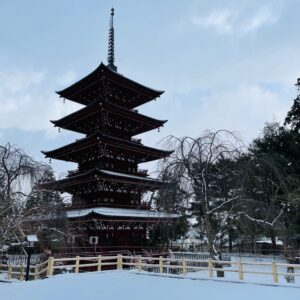

There is “Choshoji” in the innermost part of Zenringai. “Choshoji” is a temple of the Soto sect and is a family temple of the Tsugaru clan, the lord of the Hirosaki domain. Sanmon, Mikagedo, Main Hall, Kuri, Tsugaru Family Tamaya, and Bronze Bell are national important cultural properties. In particular, Sanmon, which was built in 1629, was a wonderful building.
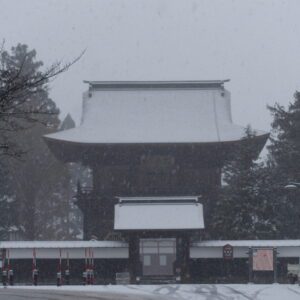

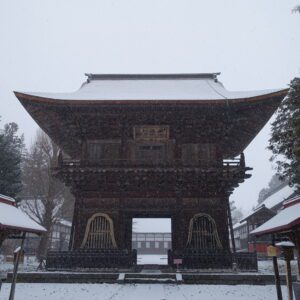

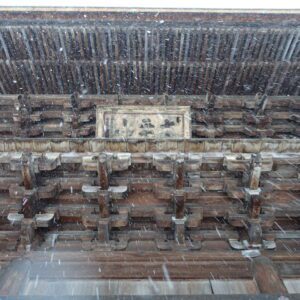





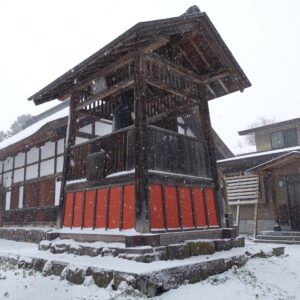

After lunch, I walked in the snowstorm and went to “Former Kaikousha Building”. “Former Kaikousha Building” was built in 1907 in Hirosaki City as a meeting place and social gathering place for former Army officers. It is a national important cultural property.
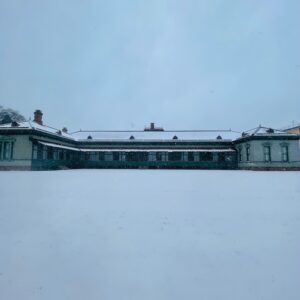

Next to “Former Kaikousha Building”, there is “Former Fujita Family Residence (Dazai Osamu Manabi no Ie)”. This is the house where Osamu Dazai (Shuji Tsushima) spent three years in the old high school days from 1927 to 1930.


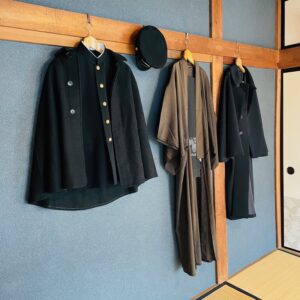

After “Former Fujita Family Residence (Dazai Osamu Manabi no Ie)”, I went to “Tsugaru-han Neputa Village” by bus.


Hirosaki Neputa is designated as a national important intangible folk cultural property. The difference between “Hirosaki Neputa” and “Aomori Nebuta” is that the fan-shaped lantern with the Neputa picture is “Hirosaki Neputa” and the horizontally long three-dimensional doll lantern is “Aomori Nebuta”. The first one of the next photo is “Hirosaki Neputa” and the second one is “Aomori Nebuta”.





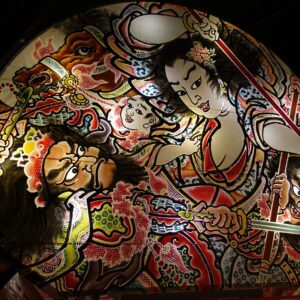



You can also listen to live Tsugaru shamisen music every day. On the day I visited, I heard a wonderful performance by Chikako Fukushi, a shamisen master .
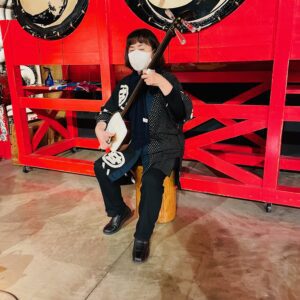

In “Tsugaru-han Neputa Village”, there is a Japanese garden “Yokien” which is designated as a national registered monument.
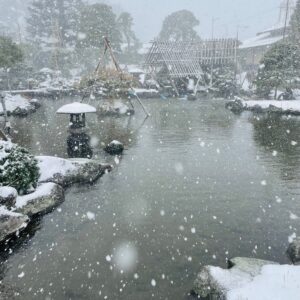

Meals
While visiting sightseeing spots, I ate miso ramen at “Nakamiso” in the basement of the Nakasan Hirosaki store. “Nakamiso” is a favorite food of Hirosaki citizens.



Before getting on the train to Akita station, I had apple pie and raw cider at “BRICK A-FACTORY” on the 2nd floor of Hirosaki station. The apple pie was supervised by the pastry shop “Bonjour” (Hirosaki City) and was very delicious.


After arriving at Akita Station and checking in at the hotel, I had dinner at the izakaya “Toppin Pararinopu”. The meaning of “Toppin Pararinopu” is Akita dialect, which means “Happy end”, “Yes, this is the end” and so on.
The izakaya “Toppin Pararinopu” has robatayaki (called “Genshi-yaki” in “Toppin Pararinopu”), and you can enjoy delicious local dishes, seafood, meat dishes, etc. in a very nice atmosphere.


The combination of Otoshi (small appetizer) and Akita Prefecture’s craft beer “Tazawako Beer” Alt was also very delicious.
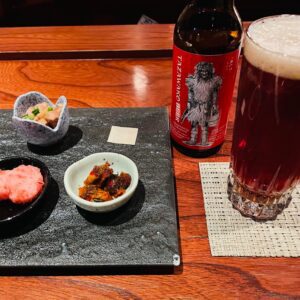

I ordered 2 pieces of sashimi (Mirror dory, greater amberjack), Grilled Shiitake Mushroom, and Grilled Hatahata (Japanese sandfish).
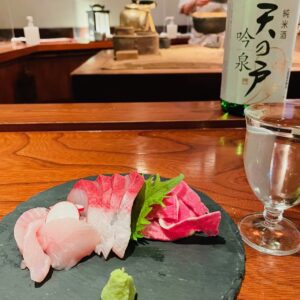

Mirror dory (left side of the above photo) is a fish caught mainly in Akita prefecture, but it is a rare fish with a very small catch.
Grilled Japanese sandfish is baked at the fireside using precious raw Japanese sandfish that is not frozen. In recent years, poor fishing has become conspicuous, and it is becoming difficult to eat raw Japanese sandfish even in Akita. The bubble wrap texture of the large egg (Brico) was very delicious.






Japan Fisheries Co-operative has selected “Akita Hatahata” as the “PRIDE FISH” for winter in Akita Prefecture.
After “Toppin Pararinopu”, I went to the reserved “Akita Kiritanpoya”. I ordered “Gakko Nata-zuke”, “Hatahata Shirako (soft roe) – zuke”, “Hatahata Sashimi”, “Water shield”, and “Kiritanpo Nabe (Hot pot)”, all of which are Akita’s local dishes.
“Gakko” means “pickles”. “Nata-zuke” is a pickle made by shaving daikon radish with a hatchet, salting it, and then pickling it in amazake.


“Hatahata Shirako (soft roe) – zuke” was the first delicacy I ate. “Hatahata sashimi” was a sashimi of small Japanese sandfish pickled in vinegar.
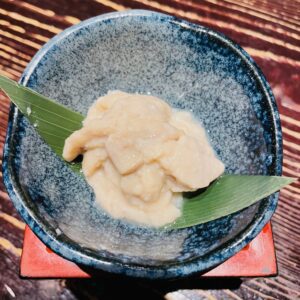



90% of the domestically produced “Junsai (water shield)” is produced in Mitane Town, Akita Prefecture. Today, 80% of the “water shield” eaten in Japan is made in China.


The Kiritanpo hotpot had a simple taste and was delicious. Kiritanpo is made by putting what was baked at the back of the hearth in a pot. The Ministry of Agriculture, Forestry and Fisheries has selected Kiritanpo Nabe as one of the “100 Best Local Cuisine”.






Important points
Reservations are required, but you can tour the inside of the “Former Kaikousha Building”. Guided is once a day from 12:00 to about 40 minutes. The tour fee is Yen 500 per person. You can also tour without a guide from 9:00 to 16:00. The tour fee is Yen 300 per person.
In Hirosaki City, the “Dotemachi Circulation Bus” that goes around Hirosaki Park from Hirosaki Station runs for a fare of Yen 100. The bus runs every 10 minutes, making it a very convenient bus for travelers.
8. December 14 (Tuesday) Akita Prefecture Day 1
On the 4th day of my trip to Aomori and Akita, I went sightseeing in Akita city. First of all, I went to Tentokuji temple.


Tentokuji is a temple of the Soto sect (Zen sect). It is the family temple of Mr. Satake, the lord of the Kubota domain (Akita domain). The main hall, the Shoin, the Sanmon, the Somon, and the Satake family sacred house are national important cultural properties. The main hall was built in 1687, the Shoin in 1806, the Sanmon in 1709, the Somon in the early 17th century, and the Satake family sacred house in 1672.
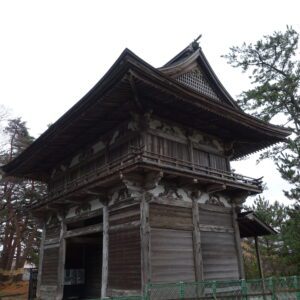



After Tentokuji, I went to “AKARENGA-KAN Museum”.
“AKARENGA-KAN Museum” is a building completed in 1912 as the former Akita Bank head office. It is a national important cultural property.
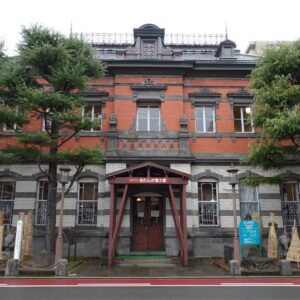



You can tour the inside of the “AKARENGA-KAN Museum”. The plaster reliefs and giant chandeliers on the ceiling of the old business room in the first floor hall are worth a visit.




On the first floor of the “Neburi nagashi-kan”, the Kanto Festival’s Kanto and The Hikiyama Parades of Tsuchizaki Shinmeisha Festival’s Hikiyama are on permanent display. The Akita Kanto Festival and the The Hikiyama Parades of Tsuchizaki Shinmeisha Festival are national important intangible folk cultural properties.
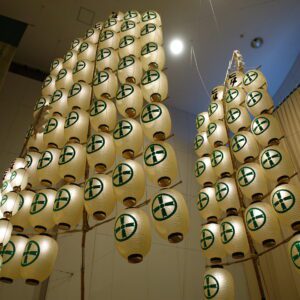

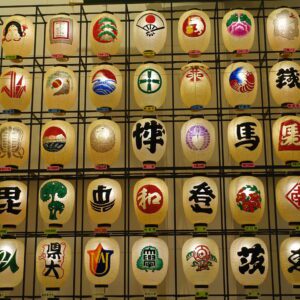

There is also a challenge corner where you can actually experience the Kanto performance. I also tried to bring a Kanto for the lower grades of elementary school, but I couldn’t hold it well because it was much heavier than I had imagined and it was long. I was able to understand how advanced skills are required for acting with a Kanto for adults.
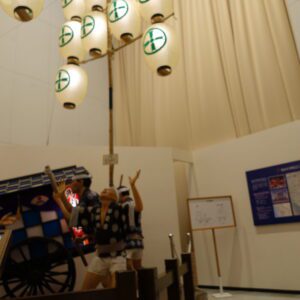

Next to the “Neburi nagashi-kan”, there is the “Former Kaneko Family Residence”. The “Former Kaneko Family Residence” is a townhouse in the late Edo period, and the interior remains quite beautiful. It is designated as a tangible cultural property of Akita City.




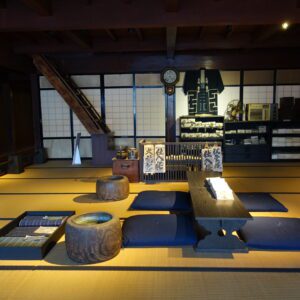

The ceramic plate relief of “Fisherman Sanpei”, a masterpiece of Takao Yaguchi, a manga artist from Akita Prefecture, decorated the lobby of Akita Airport as a public art. It is a large relief with a width of 6.7 meters and a height of 3.5 meters.
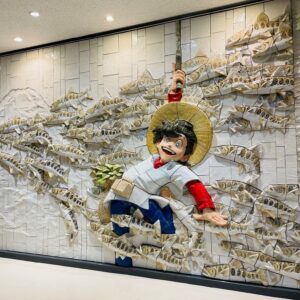

Meals
The meal on the 4th day (final day) of the Aomori / Akita trip was from “Inaniwa udon”. “Kanbun Gonendo” is a udon shop that offers raw noodles of “Inaniwa udon”, which is one of the few in Akita prefecture. It has also been selected as one of the 100 Tabelog restaurants.



“Inaniwa Udon Mugendo Akita Ekimae Store” has only dried noodles, so I had no choice but to eat dried noodles Zaru udon (Yen 740). “Inaniwa udon” from “Mugendo” was also very delicious.


After sightseeing in Akita city, I drank craft beer produced in Akita city at “TO-MART”.
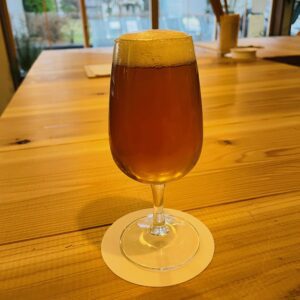



I had dinner at “Isabaya.” in Topico of the Akita Station Building. At “Isabaya.”, After ordering all-you-can-drink for 60 minutes (Yen 980), 3 kinds of sashimi, Dadami sashimi, iburi-gakko cream cheese, Namero and Yokote yakisoba.
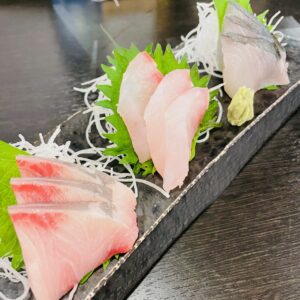

Dadami sashimi was the best of the day. Dadami is the soft roe of Pacific cod. I think that sashimi is often referred to as “Shirako ponzu” nationwide. Dadami is Akita prefecture, Yamagata prefecture, Toyama prefecture, Fukui prefecture, etc. In Hokkaido and Aomori, Shirako is called “tachi”.
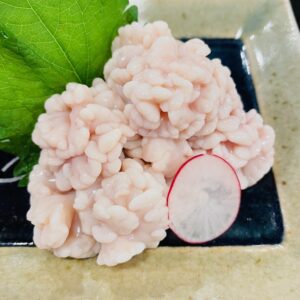

Iburi-gakko cream cheese is a typical Akita local dish. In Akita prefecture, pickles are called “gakko”.



The last item I ordered, “Yokote Yakisoba,” is a local dish of Akita prefecture. The Ministry of Agriculture, Forestry and Fisheries has selected “Yokote Yakisoba” as a “Local dishes loved by the nation”. Someday I would like to eat authentic “Yokote Yakisoba” in Yokote City.



There was a large amount of Hatahata (Japanese sandfish) in a styrofoam box outside the Isabaya. It was a beautiful Japanese sandfish. Also, I would like to come back to Akita in December to eat Hatahata.



Important points
Considering the influence of snow, I gave up going to the “Oga Shinzan Forlklore Museum” and “Namahage Museum” on the Oga Peninsula that I was planning to visit. According to the information I heard at the tourist information center of Akita Station, in order to go to “Oga Shinzan Forlklore Museum” and “Namahage Museum” by public transportation, you need to make a reservation by the day before even if you use a fixed-route bus or a shared taxi “Namahage Shuttle”. Winter travelers like me may have to change their itinerary due to snow, so I think it’s quite inconvenient to have to make a reservation the day before.
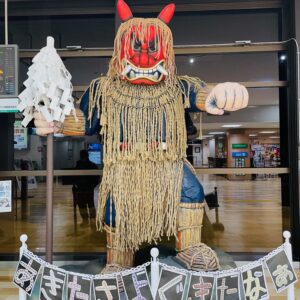

Note: The departure / arrival times, fares, admission fees, meal fees, etc. of transportation listed in the text are as of the time of writing the BLOG. Please check for yourself when you go on a trip as it may change in the future.
